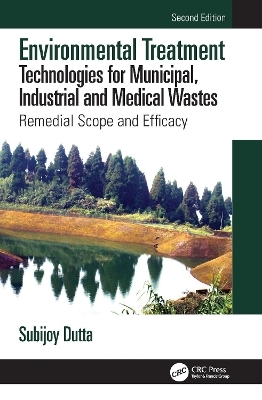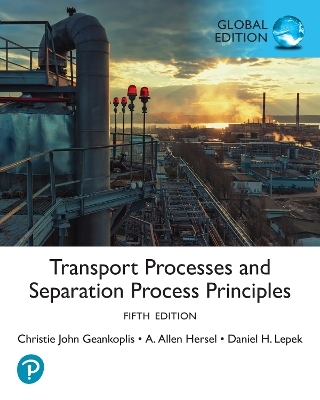
Environmental Treatment Technologies for Municipal, Industrial and Medical Wastes
CRC Press (Verlag)
978-1-032-05821-4 (ISBN)
Environmental Treatment Technologies for Municipal, Industrial and Medical Wastes will provide the reader with a simple and clear path to analyze the full range of options to manage/treat any solid, hazardous, or medical waste problems/issues at hand.
This book aims to disseminate information on available remediation treatment technologies to developing and developed countries. It also includes adequate information on all available treatment technologies for different types and categories of waste (hazardous, non-hazardous municipal solid waste, and medical waste). The technologies are grouped into the following categories: Containment technology; Soil washing; Thermal treatment; Vapor extraction; Bioremediation including Phytoremediation; Plasma/Incineration; Other Physical/Chemical treatments. It enlightens the effect of emissions during remediation activities on climate change and suggests measures to identify and control such emissions. It also covers the application of remote sensing technologies with examples and the impending issues of proper disinfection and disposal of COVID-19 related waste pertaining to the current pandemic.
It is intended for almost anyone — ranging from college students and early career professionals interested in environmental pollution control, to graduate students, researchers and experienced professionals.
This book will:
cover several recent developments on various treatment technologies, including in situ applications and their emission/migration control methods including remote sensing technologies; deal with municipal solid waste, their treatment/disposal methods, recycling, and reuse in addition to the hazardous and medical waste management program;
assist civil/environmental engineering students and local community organizations in evaluating the impact of an industry and its associated waste produced on-site; and
cover how best to treat/manage the waste to arrive at a safe operation without impacting human health and the local environment.
Subijoy Dutta is a registered professional engineer (P.E.) in Maryland, USA. He has authored two books : “Sustainable Mining Practices – A Global Perspective”, published July 2005 by Balkema Publishers and “Environmental Treatment Technologies for Hazardous and Medical Wastes”, published in March 2002 by Tata McGraw Hill Publishing. Mr. Dutta received his BS in Mechanical Engineering from the Assam Engineering College, Guwahati, India in 1972. He completed his first MS in Mechanical Engineering from the University of Oklahoma, Norman, Oklahoma USA in 1981. In 1984 he finished a second MS in Petroleum/Geological Engineering from the same Oklahoma University In 1992 he stepped forward to provide help towards cleaning the Yamuna River. He collected an inordinate amount of data, and met with the Delhi authorities and offered to provide assistance. He formed the Yamuna Foundation in 2000 and had many local volunteers in Agra and Delhi area. He later founded the Rivers of the World Foundation in 2007 along with a few esteemed professionals in US. Mr. Dutta worked for the US EPA in Washington, DC for 20 years as a Senior Engineer. He has assisted the Central Pollution Board, New Delhi, in their development of regulations and guidance concerning medical waste management and landfills Mr. Dutta received the National Award in Washington, DC for Individual Excellence in Environmental Restoration from U.S. Air Force in 1991 from the Air Force Chief of Staff, Merrill McPeak in Washington, DC. This outstanding performance, and cash award was given to recognize his work on design and implementation of a superfund site, a radioactive waste disposal site and three toxic landfill sites within 2.5 years at the Tinker Air Force Base in Oklahoma City, OK. In 1997 Mr. Dutta received EPA’s Unsung Hero of the Year Award from EPA Administrator, Carol Browner for his dedicated voluntary work spending his personal funds towards the Yamuna River cleanup efforts in India.
Chapter 1.Introduction
Chapter 2.Site Remediation Process
Chapter 3.Introduction and Overview
Chapter 4.Containment Technologies
Chapter 5.Soil Washing
Chapter 6.Thermal Treatment
Chapter 7.Vapor Extraction
Chapter 8.Bioremediation
Chapter 9.Incineration Treatment
Chapter 10.Other Physical/Chemical Treatments
Chapter 11.Case Studies of Treatment Technologies
Chapter 12.Common Activities During Cleanup Operations
Chapter 13.Monitoring & Control of Cross-Media Transfer of Contaminants During Cleanup Activities
Chapter 14.Treatment Options For Medical Waste
| Erscheinungsdatum | 06.09.2021 |
|---|---|
| Zusatzinfo | 17 Tables, black and white; 24 Line drawings, black and white; 14 Halftones, black and white; 38 Illustrations, black and white |
| Verlagsort | London |
| Sprache | englisch |
| Maße | 174 x 246 mm |
| Gewicht | 490 g |
| Themenwelt | Technik ► Umwelttechnik / Biotechnologie |
| ISBN-10 | 1-032-05821-8 / 1032058218 |
| ISBN-13 | 978-1-032-05821-4 / 9781032058214 |
| Zustand | Neuware |
| Informationen gemäß Produktsicherheitsverordnung (GPSR) | |
| Haben Sie eine Frage zum Produkt? |
aus dem Bereich


